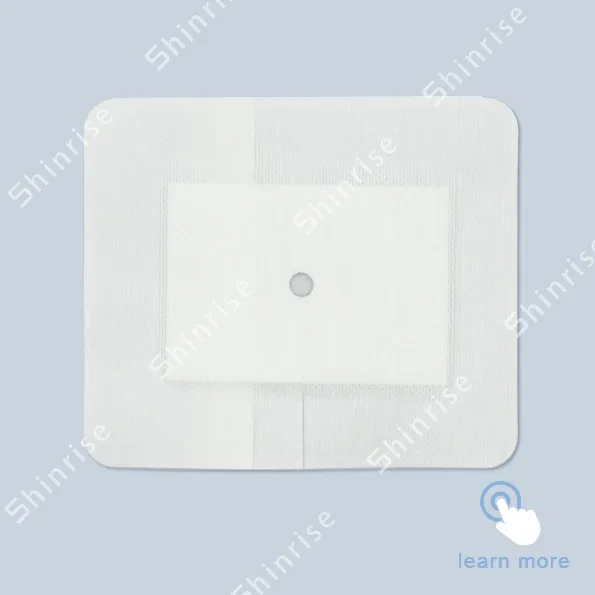Email cannot be empty
Password cannot be empty
Email format error
Email cannot be empty
Email already exists
6-20 characters(letters plus numbers only)
The password is inconsistent
Email format error
Email cannot be empty
Email does not exist
6-20 characters(letters plus numbers only)
The password is inconsistent


The Magic of Antibacterial Wound Dressings: Healing Beyond the Surface
Wounds are an inevitable part of life. Whether it's a small cut from cooking, a scrape from a fall, or a surgical incision, our bodies are constantly at risk of injury. When these injuries occur, the primary concern often revolves around healing. However, the healing process isn't as straightforward as it might seem. One of the critical factors that can influence how well and how quickly a wound heals is the choice of dressing used on the injury. This is where antibacterial wound dressings come into play, providing not just a protective barrier but also actively promoting healing by combating infections.
Understanding Wounds and Their Healing Process
Before diving into the benefits of antibacterial wound dressings, it’s essential to understand the nature of wounds. A wound occurs when the skin is broken or damaged, exposing underlying tissues. This can trigger various responses in the body, including inflammation, the formation of new tissue, and eventually, the healing of the skin.
The healing process can be divided into several stages:
Hemostasis: This is the immediate response to injury, where blood vessels constrict, and platelets gather to form a clot, stopping the bleeding.
Inflammation: This phase lasts for a few days, during which the body sends white blood cells to the injury site to combat bacteria and begin the healing process.
Proliferation: In this stage, new tissue begins to form. The body rebuilds itself by creating new blood vessels and collagen, which helps in closing the wound.
Maturation: The final phase can last for months to years, where the new tissue strengthens and matures.
While this is a simplified view of the healing process, it's clear that various factors can affect it. One significant concern is the risk of infection, which can delay healing and lead to more severe complications.
The Role of Antibacterial Wound Dressings
This is where antibacterial wound dressings come into the picture. Unlike traditional dressings, which primarily serve to cover and protect wounds, antibacterial dressings offer a more proactive approach to wound care. They contain substances that can kill or inhibit the growth of bacteria, thus reducing the risk of infection.
How Do Antibacterial Wound Dressings Work?
Antibacterial wound dressings come in various forms, including films, foams, and hydrocolloids. They can be infused with antimicrobial agents such as silver, honey, or iodine, which have been proven effective in fighting bacteria.
Silver: Silver ions have long been recognized for their antibacterial properties. They can disrupt bacterial cell membranes and interfere with their metabolism, leading to bacterial death. Silver dressings are especially popular in the treatment of chronic wounds.
Honey: Manuka honey, in particular, is renowned for its healing properties. It not only has natural antibacterial effects but also promotes tissue regeneration and helps maintain a moist wound environment, which is essential for healing.
Iodine: Iodine-based dressings, like povidone-iodine, release iodine over time to kill bacteria. They are often used for surgical wounds and other high-risk injuries.
Benefits of Using Antibacterial Wound Dressings
Reduced Infection Rates: The primary benefit of using antibacterial wound dressings is their ability to reduce the risk of infection. With fewer bacteria present at the wound site, the body's natural healing processes can work more effectively.
Faster Healing Times: Studies have shown that wounds treated with antibacterial dressings often heal faster than those treated with traditional dressings. This is particularly crucial for chronic wounds, such as diabetic ulcers, where healing can be significantly prolonged.
Improved Patient Comfort: Many antibacterial dressings are designed to be comfortable and less painful upon removal. They often cause less trauma to the wound site, minimizing discomfort for patients.
Moisture Management: A moist wound environment is beneficial for healing. Antibacterial dressings can help maintain this environment while also absorbing excess exudate, preventing the wound from becoming too wet.
Ease of Use: Many of these dressings can be applied easily and do not require frequent changing, making them convenient for both patients and caregivers.

The Science Behind Antibacterial Dressings
Research supports the effectiveness of antibacterial wound dressings in various clinical settings. Numerous studies have demonstrated that these dressings can significantly reduce bacterial load in wounds and promote healing.
For instance, a clinical trial involving patients with diabetic foot ulcers found that those treated with silver-infused dressings experienced a faster reduction in wound size compared to those with standard dressings. Similarly, another study indicated that patients with surgical wounds treated with honey dressings had a lower incidence of infections and improved healing times.
These findings highlight not only the effectiveness of antibacterial wound dressings but also their potential to transform wound care practices. By integrating them into treatment protocols, healthcare providers can enhance patient outcomes and reduce the burden of wound-related complications.
Choosing the Right Antibacterial Wound Dressing
With the myriad of antibacterial wound dressings available, choosing the right one can be overwhelming. Here are some factors to consider:
Type of Wound: The nature of the wound (e.g., acute, chronic, surgical) plays a significant role in determining the most appropriate dressing. For example, silver dressings may be ideal for chronic wounds, while honey dressings might be better suited for superficial wounds.
Level of Exudate: Assess the amount of drainage from the wound. Some dressings are designed for high-exudate wounds, while others are better for low-exudate situations.
Sensitivity and Allergies: Patients may have sensitivities to certain materials or chemicals used in dressings. It’s essential to consider any known allergies when selecting a dressing.
Cost and Accessibility: While many antibacterial dressings are highly effective, they can also be more expensive than traditional options. It’s crucial to balance cost with the expected benefits, especially in long-term care situations.
Consultation with Healthcare Professionals: It’s always wise to consult with a healthcare provider when dealing with wounds, especially those that are severe or chronic. They can provide personalized recommendations based on individual needs.
Real-Life Applications and Experiences
The use of antibacterial wound dressings isn't just limited to clinical settings; they are becoming increasingly popular in home care as well. Many individuals are discovering the benefits of these advanced dressings for treating minor cuts and scrapes at home.
Take the example of a mother who has two young children. With all the adventures and mishaps that come with raising kids, she often finds herself dealing with scrapes and cuts. Instead of using traditional bandages, she now relies on antibacterial wound dressings. Not only do these dressings help prevent infections, but they also allow her children to play freely without the constant worry of their injuries worsening.
In another instance, a professional athlete suffered a minor injury during training. He used an antibacterial dressing infused with silver. Not only did it protect the wound, but it also expedited his recovery, allowing him to get back to training faster than expected. His experience highlights how even minor injuries, when treated properly, can lead to quicker returns to physical activity.
The Future of Wound Care
As the field of wound care continues to evolve, we can expect to see even more innovations in antibacterial wound dressings. Researchers are exploring new materials and methods to enhance the effectiveness of these dressings, such as smart dressings that can change color to indicate infection or those that release medication over time.
Moreover, with an increased focus on personalized medicine, we may see antibacterial wound dressings tailored to individual patient needs, taking into account specific wound characteristics and patient health conditions.
Conclusion
Antibacterial wound dressings represent a significant advancement in wound care, providing effective protection against infection while promoting faster healing. Their ability to create a favorable environment for recovery makes them invaluable for anyone dealing with injuries, from everyday cuts and scrapes to chronic wounds.
By understanding the benefits and proper use of antibacterial wound dressings, we can take a proactive approach to wound care, ensuring not just faster healing but also improved overall health and well-being. So, the next time you find yourself tending to a wound, consider the power of antibacterial wound dressings to help you heal not just on the surface, but from within. After all, in the world of wound care, a little extra protection can go a long way.

